We are excited to announce the release of workspaces, the new site management experience in ArcGIS Hub. Workspaces modernize and streamline the interface, offer more configuration options, and add value to ArcGIS Hub Premium. Hub site owners, data managers, and other editors: join this short excursion into the basics of workspaces.
Workspaces expands functionality and provides more efficient patterns of navigation. While editing, it’s a quick and clear path from a workspace to a layout to viewing live changes, and also when moving among related items such as groups and content connected to a site.
Workspaces are the places where you go to get things done. Managing content, capabilities, and preferences with workspaces is now the default, replacing classic edit mode. You can edit information and manage certain settings for your site, pages, initiatives (Premium), content, and other items in the relevant workspace.
The live site view still shows global navigation (when enabled) and header content, such as your site’s title, logo and navigation menu.

The layout editor is still where you design your sites and pages using a wide array of drag-and-drop layout cards.
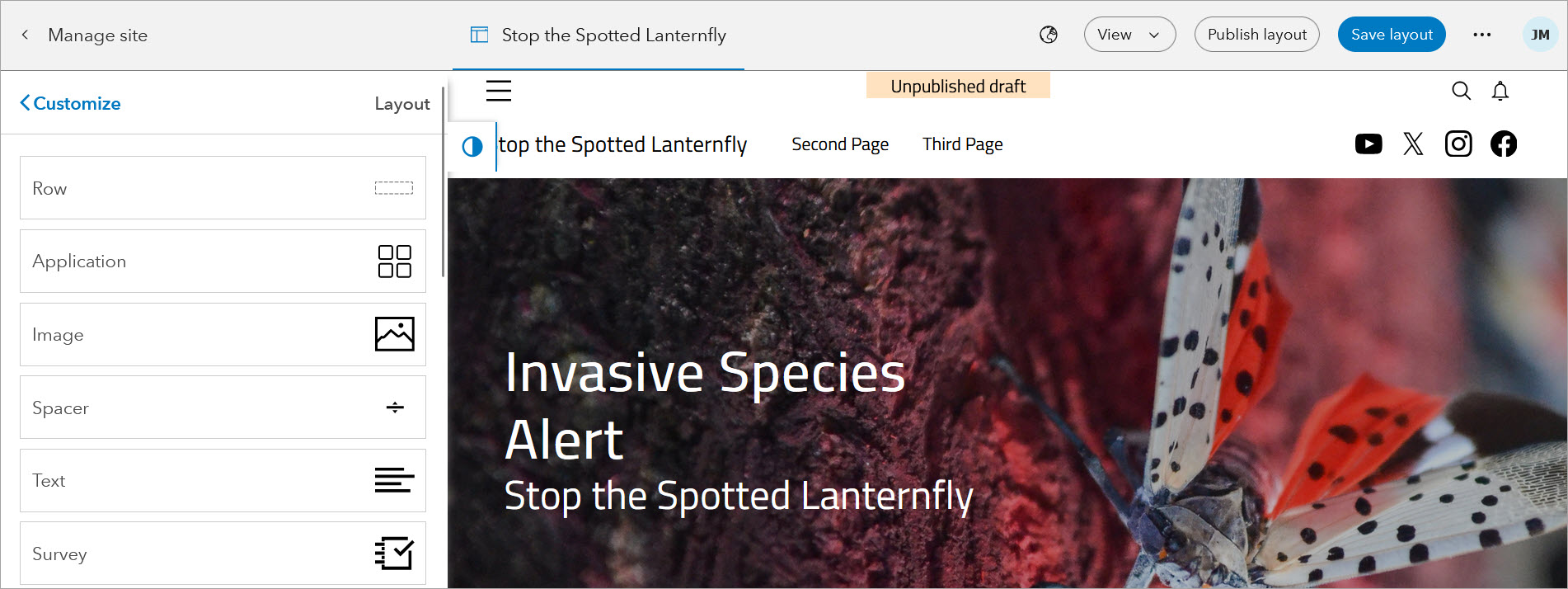
You may already be using workspaces, which have been available in beta for some time. If you edited a project in ArcGIS Hub Premium, you have used the project workspace. Customers who previously opted in to workspaces and edited a site summary or added tags, have used the site workspace. With general availability, you now have that familiar interface across Hub.
Make use of a more consistent interface
While signed in to an item’s live view, select the Manage button on the sidebar to open the workspace for that item (if you have permissions to edit).
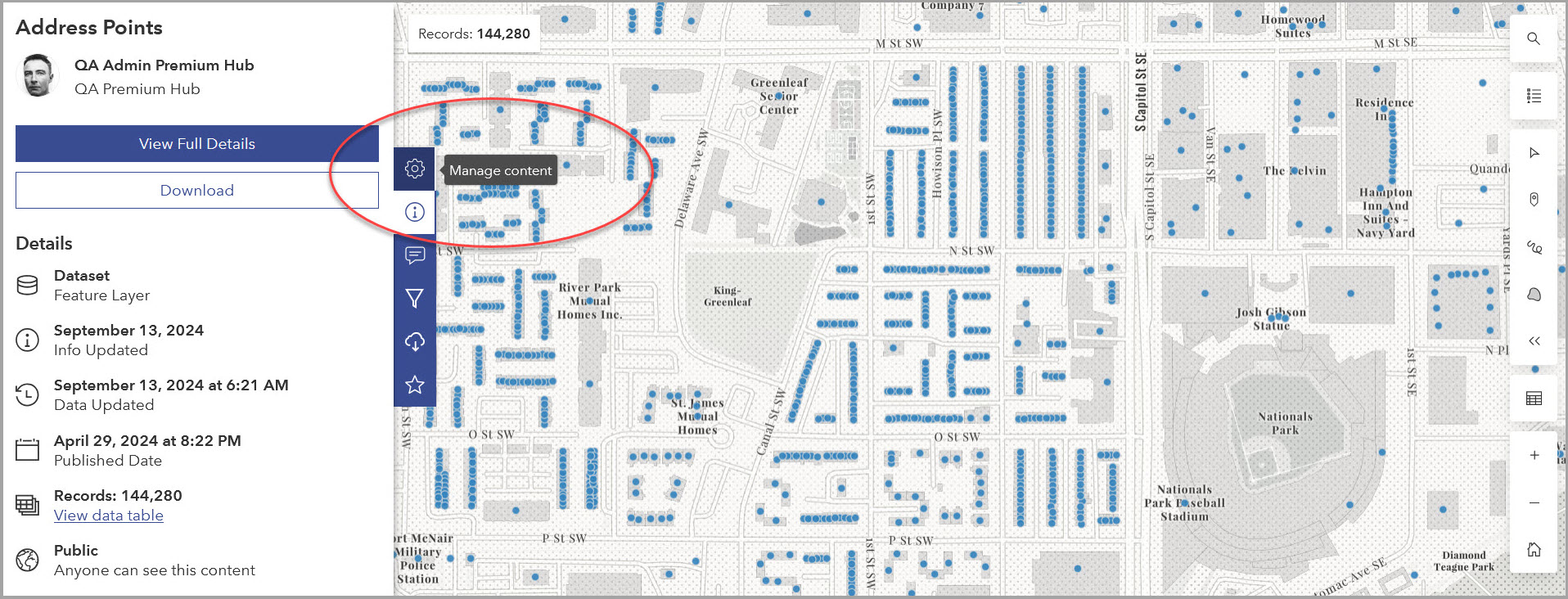
The workspace interface is standardized across various items with a few specialized panes and settings, depending on the item. Most items such as sites, pages, groups, events, and content, have the following panes:
- Details pane- title, summary, thumbnail, location, etc.
- Settings > General pane- deletion settings
- Settings > Sharing pane- sharing level, adding groups to view or edit the item

With Hub Premium, the site workspace also has a pane for Followers, as these are managed at the site level. The site, initiative, and project workspaces have catalogs that you can configure for content and events.
The initiative workspace has a projects pane, while the projects workspace has an initiatives pane. This facilitates associations: built-in ways to connect related projects and initiatives.
Explore the Hub user workspace
Each user has a workspace to access key workflows and applicable settings, and find content, groups, and events. After you sign in to Hub, navigate to your workspace from your user profile by selecting View workspace. This workspace is your homebase and starting place. If you make changes on any pane, save your edits before navigating away. This applies to all workspaces.
The Overview pane includes your recently modified content. On the Content pane, you can view and search items and display them as a grid, map, and more. Select the name of an item to view it.

Select the Manage button (visible if you have edit access) to open the workspace of that item.

Hub Premium customers can search, filter, and view their events on the Events pane. On the Groups pane, you can access your ArcGIS Online groups (and Hub teams used previously). Select a group name to view it or for groups that you can edit, select the Manage button to go to the group’s workspace.
Take a trip into the group workspace
The Hub group workspace is where you manage the content and membership of migrated teams and other groups. These short videos offer introductions to content and groups:
In the group workspace, you can edit details such as title, summary, and thumbnail. Go to the Members pane to browse, search, and add members to the group.
Jump back into the user workspace
From the workspace of any item such as a site, page, group, or content, just select My workspace to go back to your user workspace.
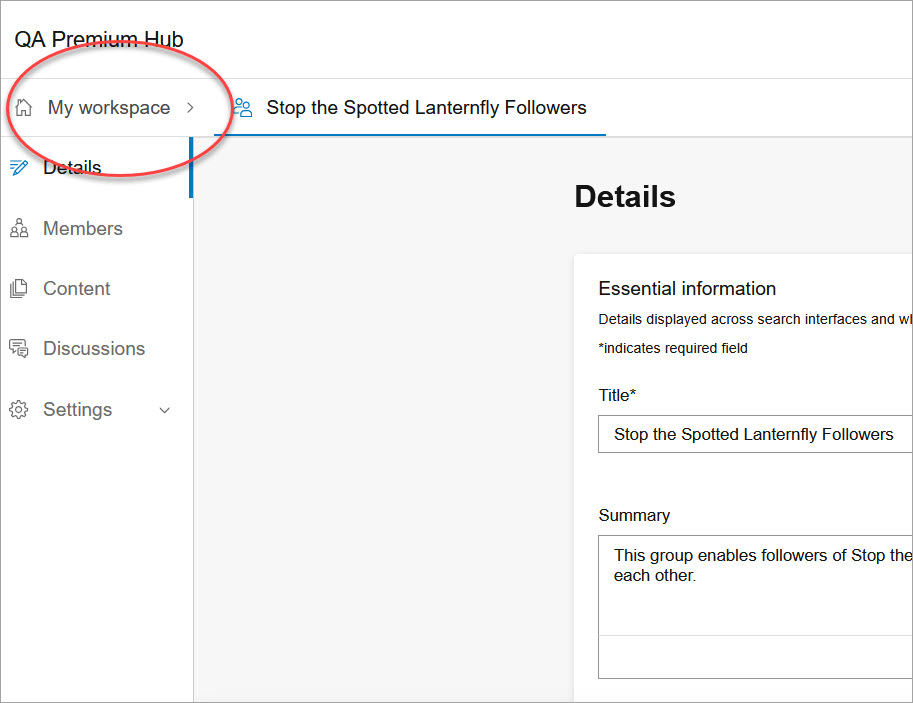
If you are an organization administrator, you can access additional organization settings in your user workspace. Most primary (employee) and community (Hub Premium) organization settings are now managed in ArcGIS Online, instead of in Hub. A link will take you to the ArcGIS Online home page for the organization that you are signed in to.
If you are signed in to the community organization as a community administrator, you will see a link to the ArcGIS Online home page of the Hub Premium community organization.
Discover the ever ready Create button
Hub workspaces makes it easy to create items. A Create button is always available on the global navigation header. This button allows you to create a site, page, group, initiative, project, discussion board, event, and other content (in ArcGIS Online).
The options you see for this button depend on the license level of your organization, your privileges, and the context of what you are viewing. With Hub Premium, site editors have access to initiatives, projects, discussions, and events.

When you create a site, you can share it with groups of people to view or edit the site. Hub no longer generates default groups such as the core team group and the content group. Use existing groups or create groups based on the ArcGIS Online model.
For example, create an edit group (shared update group) and connect it to a site for group members to be able to edit the site layout and workspace information. Or add a view group (view only group) from your organization so that group members can search and view the site, if it is not shared to the public .
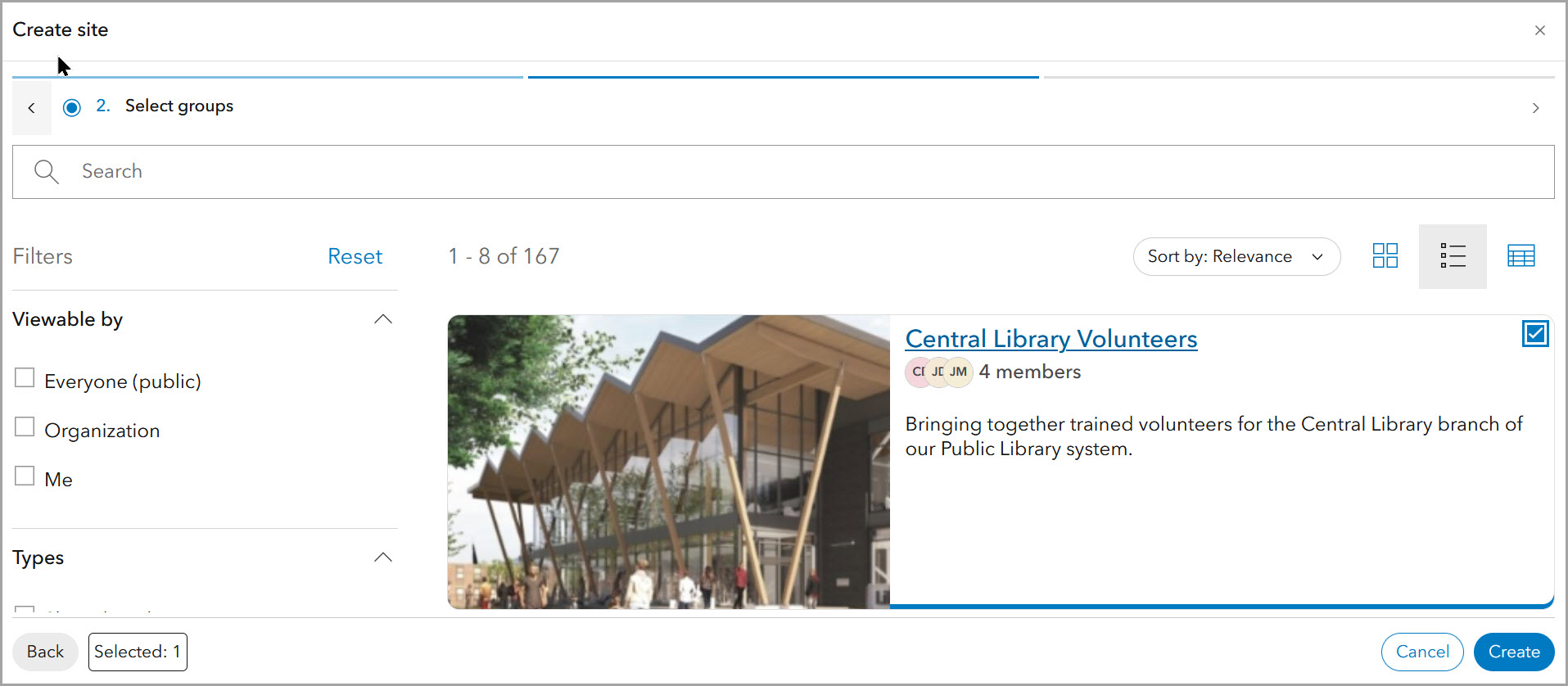
Tour the site workspace
From your user workspace (Content pane), open a live view of a site by selecting the title. If you have edit permissions, you can then open the site layout editor and other settings (select the Edit button) or the site workspace (select the Manage site button).
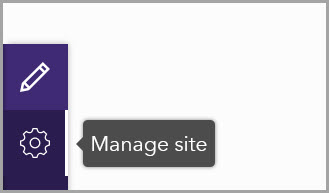
The Dashboard pane shows summary metrics for the site such as page views and sessions. You can change the timeframe for the metrics displayed and subscribe to a weekly report.
On the Details pane, you can edit site information such as title and description to appear in the site view. Add tags and categories to optimize discovery of the site. You can also edit these details in ArcGIS Online. If you make changes on any pane, be sure to save your edits before navigating away (this applies to all workspaces).
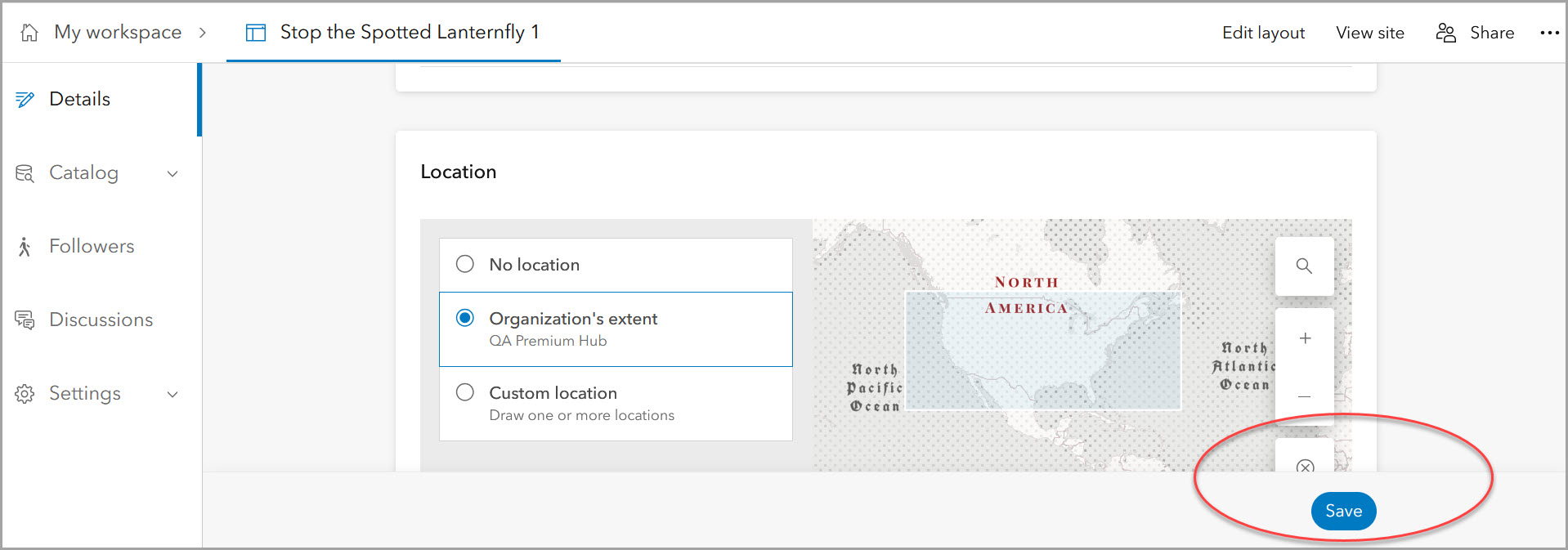
Configure a site catalog
Sharing trusted and curated content is a core capability of ArcGIS Hub. Catalogs allow visitors with the appropriate permissions to search and view your shared documents, data, maps, apps, and more. Site catalogs are currently powered by groups and collections. It is now easier to manage those groups and share your authoritative data and other content.
Configure your site’s catalog on the Catalog, Content pane in the site workspace. Content shared with catalog groups is automatically indexed by the site catalog. To add additional content to your site catalog, share it with the groups connected to your site.

After a site catalog is configured, you can create content and add it directly to the catalog by using the Add content button within the catalog. You can also add items that are already in ArcGIS Online and upload content or create applications in ArcGIS Online.
Hub Premium customers can also configure a site catalog for events. Additionally, a Hub Premium license includes the ability to build custom catalogs for content and events with advanced options, for both initiatives and projects.
Explore enhanced events
Events, available with Hub Premium, are now easier to create and manage with workspaces. An administrator is not required to enable collaborative events and Hub no longer creates a default group for attendees of each event.
Event owners can share events using groups. Event editors can manage event details and registrants in the event workspace. Learn more about Enhanced events – now available in ArcGIS Hub! in this blog.
Set up site access and sharing
Let’s hop back into the site workspace. With the transition from teams to groups, you no longer need to manage teams in Hub and can use any ArcGIS Online group to collaborate. You will see previously linked teams such as the core team, supporting team (Hub Premium), and content group in the site workspace. Add any supporting teams as groups with the appropriate view or edit access to continue using them.
Set the sharing level to scope to just your organization, make the site fully public, or keep it private. Share the site with view groups (view only groups) or edit groups (shared update groups). After saving, view the site or open the site layout editor (Edit layout button), where you can migrate any linked pages
Manage pages as part of a catalog
Hub sites commonly have one or more pages. Catalogs and workspaces simplify how pages are managed. Any page shared in the site’s catalog will appear in your site’s search results and can be added to the site’s header menu as a link.
Managing pages in workspaces requires a one-time page migration. The site builder includes two tabs. The Pages tab shows pages that are in the groups of your site’s catalog. The Migration tab shows pages that are linked to your site using the former method of adding pages to a site. Each page listed here must be migrated to a group in the catalog.
Note: Hub will support linked pages added in classic edit mode for approximately one year following the release of workspaces in general availability.
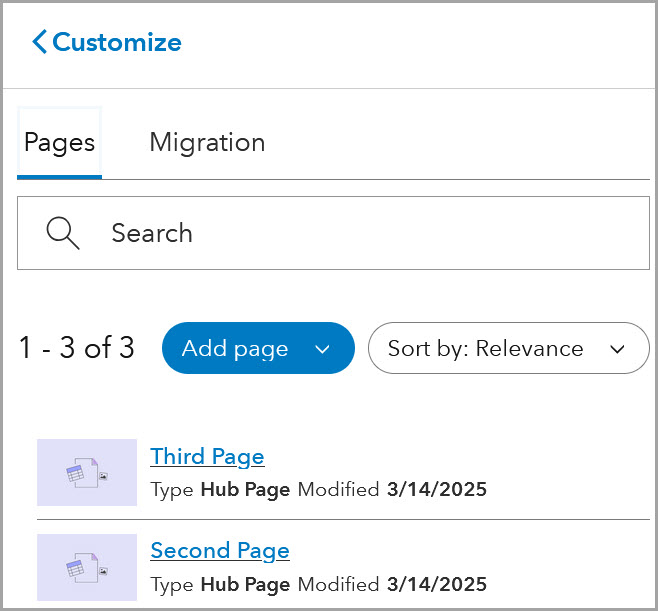
Find redefined initiatives
Continue to leverage Hub sites for your primary web presence. And be aware that with the re-introduction of initiatives, you can create an initiative independent of a site. Previously created initiatives are now standalone sites with all the same apps and data.
Hub Premium customers can use redefined initiatives to track and share work towards meeting long-term objectives. Connect related projects under one initiative and use metrics to measure progress. Read more in the Introducing redefined initiatives in ArcGIS Hub blog.
Use workspaces for optimized workflows
For a limited time, you can opt out of workspaces and use the classic edit mode. Select your user profile and select View workspace. Go to the Settings pane and select the button to turn off workspaces (return to your user profile and select Settings to re-enable workspaces).

Later, you will no longer be able to opt out of workspaces. Right now, we recommend that you use workspaces to experience the benefits of simplified and enhanced workflows. We will continue to refine and add new features in the coming months. As you use workspaces, post your questions and ideas to the ArcGIS Hub Community page.
Resources
- ArcGIS Hub documentation
- Get started– license differences, activate Hub Premium, access primary organization settings
- Community– manage the Hub Premium community organization, followers, events
- Initiatives– use Hub Premium initiatives, projects, and metrics
- Sites– add pages, edit site and page layouts, manage sites and pages in the workspace, activity tracking, custom domains
- Content– manage content items, access and sharing, configure catalogs, explore data, download settings
- Collaboration– use groups to collaborate and share content, roles and privileges, content-based discussions and discussion boards
- Sign up for the ArcGIS Hub e-newsletter.
- Inspire others by submitting your sites to the ArcGIS Hub Gallery.
- Showcase your sites by sharing them with us on LinkedIn using #ArcGISHub.
- Going to Esri UC? Be sure to Attend ArcGIS Hub Sessions & Get Your Questions Answered.

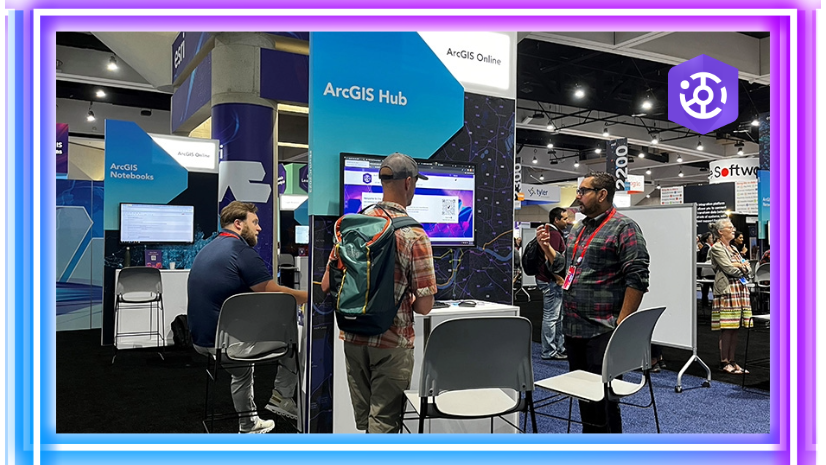


Article Discussion: